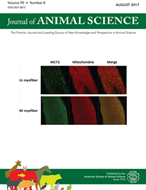-
Views
-
Cite
Cite
K. J. Wondra, J. D. Hancock, G. A. Kennedy, K. C. Behnke, K. R. Wondra, Effects of reducing particle size of corn in lactation diets on energy and nitrogen metabolism in second-parity sows, Journal of Animal Science, Volume 73, Issue 2, February 1995, Pages 427–432, https://doi.org/10.2527/1995.732427x
Close - Share Icon Share
Abstract
Thirty-eight second-parity sows were used to determine the effects of particle size of corn in lactation diets on nutrient metabolism. The sows were fed a corn-soybean meal-based diet with the corn ground to targeted average particle diameters of 1,200, 900, 600, and 400 µm. Loss of BW and backfat and litter performance were not influenced by treatment (P > .10). However, as particle size was reduced from 1,200 to 400 µm, apparent digestibilities of DM (linear effect, P < .001) and N (quadratic effect, P < .007) were increased by 7 and 10%, respectively, and fecal excretions of DM and N were decreased (linear effects, P < .001) by 35 and 42%, respectively. Urinary N excretion was not affected by particle size (P > .20), but there was a trend (P < .08) for the greatest apparent biological values at the intermediate particle sizes (i.e., 900 and 600 µm). Thus, with increased apparent digestibility and no increases in urinary loss, N retention was increased by 22% as particle size of corn was reduced from 1,200 to 600 µm (quadratic effect, P < .04). Digestible energy and ME concentrations of the diets were increased as particle size of corn was reduced from 1,200 to 400 µm (linear effects, P < .001), with a ME value of 3,745 kcal/kg for the diet with corn at 400 µm compared with 3,399 kcal/kg for the diet with corn at 1,200 µm. However, reducing particle size increased severity of ulceration and keratinization (nonzero correlations of P < .002 and P < .04, respectively) in the esophageal region of the stomach. Thus, our data indicate that for maximum nutritional value, the optimum particle size of corn in lactation diets for second-parity sows is 400 to 600 µm, but negative effects on stomach morphology should be considered.





